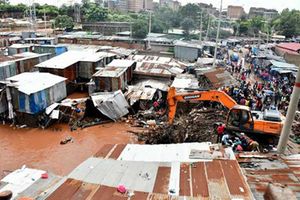Homemade bombs leave trail of death in Northern Kenya

A lorry that was damaged by an explosive on January 17, 2023, on the Lapsset road in Bura East, Tana River County.
The Tuesday attack that left several security officers nursing serious injuries has raised the alarm on the rising use of improvised explosive devices (IEDs) by al-Shabaab along the Kenya-Somalia border.
Dadaab Deputy County Commissioner Kipkirui Siele said the Border Patrol Unit (BPU) officers from Abdi Suku camp were travelling to Garissa when the vehicle they were in ran over an IED on the Dadaab-Garissa Road.
The case is similar to that of Kenya National Highways Authority (Kenha) engineer Olive Simwelo.
Mr Simwelo and two of his colleagues died following an attack suspected to be orchestrated by the al-Shabaab militia group involving a roadside explosive on the Lapsset road in Bura East, Tana River County.
The IED menace in Garissa County and its surroundings in the past five years has left hundreds of civilians and security officers dead, as others are left with painful memories.
Investigations by the Nation show that about 38 IED incidents between 2011 to 2015 killed 339 civilians and 89 security officers.
Between 2017-2021, more than 40 fatalities, both civilians and security officers, have been recorded.
Four pupils dead
In 2020, for instance, the al-Shabaab militia group targeted a communication mast using an IED. The attack killed four pupils at Seretho Primary School.
The same year, two security officers from Alinjugur police station died after a vehicle they were in ran over an IED while on patrol.
And in 2021, between Kulan and Liboi, eight police officers sustained critical injuries after their vehicle ran over an IED.
But just what is an IED? Where does the militia group get these deadly weapons and to what extent is their damage?
According to Kenya Peace and Security Support Initiative (Kepssi) Secretary-General Jacob Elkana, the devices are easily assembled.
“If you can recall in 2014 detectives impounded a Toyota Hilux car with registration number KAN 410E, the car was full of IED explosives and it was to explode with a phone call that was to be made to a Nokia phone that was attached to those IEDs," said Mr Elkana.
Mr Elkana, who is also a security expert, notes that the attackers usually consider a lot of things, among them, geolocations of deployed IEDs.
"Most of the IED attacks are carried out by al-Shabaab in revenge for Operation Linda Nchi launched when our Kenya Defence Forces soldiers entered into war zones in southern Somalia in October 2011," he says.
The attacks mainly target security forces, national infrastructure and civilians.
"IEDs usually inflict grievous physical injuries, cause terrible psychological harm. They also spread extreme fear, and disrupt communal economic activities, like on our roads," Mr Elkana adds.
Areas that have been hit recently include Kora Kora, Kulan and Liboi, Liboi-Abdisugow where 11 officers were fatally injured.
A global problem
The use of IEDs is a global problem and is rampant in countries such as Afghanistan, Iraq, Pakistan, and Syria.
The northern part of Africa including Libya, Tunisia and Egypt has also witnessed such attacks staged by Al Qaeda and ISIS terrorist groups.
"Since the decline in the supply of drugs such as cocaine and heroin among other hard stuff and smuggling of illegal goods, the attacks have reduced. Our security organs have sealed loopholes in several places such as the porous Lunga-Lunga border, in the northern part of Kenya and other areas," says Mr Elkana.
Locals have now urged security agencies to find a way to deal with challenges posed by IEDs, terming them a real security issue.
“The attacks have scared away investors. Sadly, non-local doctors and teachers went away, fearing for their lives. Those who used to have homes in the interior areas of Garissa County have shifted too,” said Mr Haretha Dubow, an area resident.
Community based organisations also closed their branches in the IED-prone areas add now locals go without essential services.





